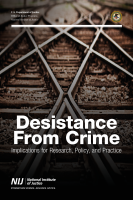Crime causes
Linking Childhood Trauma Exposure to Adolescent Justice Involvement: The Concept of Posttraumatic Risk-Seeking
Advancing Understanding, and Informing Prevention of Public Mass Shootings: Findings from NIJ Funded Studies, Part 2
In recent years, NIJ invested in several research projects to advance understanding and inform prevention of public mass shootings.
See the YouTube Terms of Service and Google Privacy Policy
Indexing of Interdisciplinary Literature on Crime, Violence, and Mental Disorder
Hate Crime Workshop Proceedings, November 15, 2005
Shooting Alone: The Pre-Attack Experiences and Behaviors of US Solo Mass Murderers
Nature and Circumstances of Defensive Gun Use: A Content Analysis of Interpersonal Conflict Situations Involving Criminal Offenders
Causes of Organized Crime: Do Criminals Organize Around Opportunities for Crime or Do Criminal Opportunities Create New Offenders?
Noble Cause: An Empirical Assessment
From Boston to Boyle Heights: The Process and Prospects of a "Pulling Levers" Strategy in a Los Angeles Barrio
Unintended Consequences of Being Stopped or Arrested: An Exploration of the Labeling Mechanisms Through Which Police Contact Leads to Subsequent Delinquency
Importance of Both Opportunity and Social Disorganization Theory in a Future Research Agenda to Advance Criminological Theory and Crime Prevention at Places
Participation in and Frequency of Delinquent Behavior: A Test for Structural Differences
Assessing the Spatial-Temporal Relationship Between Disorder and Violence
Risk and Protective Factors Related to Offending: Results From a Chinese Cohort Study
Comparative, Cross-Cultural Criminal Career Analysis
Ultimate Impacts of Sentencing Reforms and Speedy Trial Laws: A User's Guide to the Machine-Readable Files and Documentation and Codebook
Addicted Women and Crime
An Examination of the Associations Among Victimization, Mental Health, and Offending in Women
Russian Emigre Crime in the United States: Organized Crime or Crime That Is Organized?
Take My License n' All That Jive, I Can't See ... 35: Little Hope for the Future Encourages Offending Over Time
Video: Evidence-Based Practices and Strategies: Risk Terrain Modeling
Case Deconstruction of Criminal Investigative Failures
NIJ Journal Issue No. 276
Less Prison, More Police, Less Crime: How Criminology Can Save the States from Bankruptcy
Professor Lawrence Sherman explains how policing can prevent far more crimes than prison per dollar spent. His analysis of the cost-effectiveness of prison compared to policing suggests that states can cut their total budgets for justice and reduce crime by reallocating their spending on crime: less prison, more police.
See the YouTube Terms of Service and Google Privacy Policy


